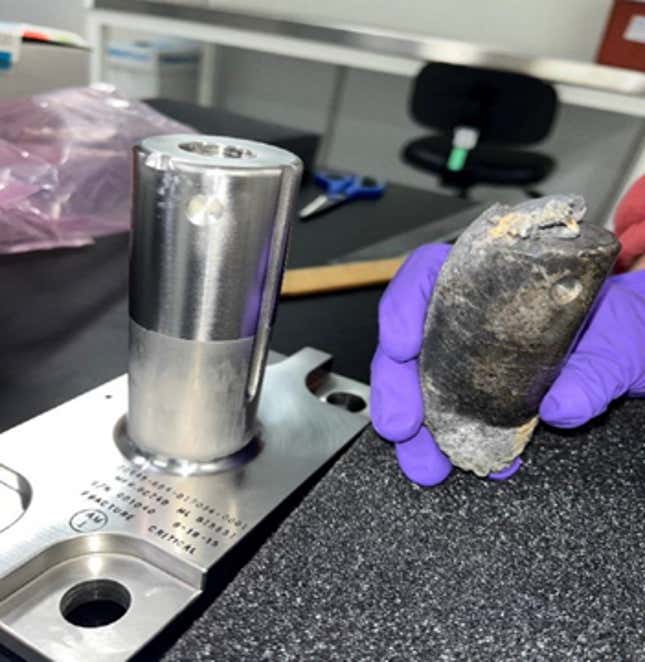[ad_1]
Properly, that is awkward. A NASA investigation confirmed {that a} small piece of trash tossed from the Worldwide Area Station (ISS) survived atmospheric reentry and ended up in a Florida residence. It is a uncommon case of house junk inflicting harm on Earth, and the house owner could also be in search of authorized motion.
In March 2021, NASA discarded an enormous pallet of outdated batteries from the orbital lab, hoping that it will expend via Earth’s environment. Three years later, a bit of steel {hardware} unexpectedly survived the heated journey, and crashed via the roof of a household residence in Naples, Florida.
The house owner reported the incident final month, and NASA retrieved the thing for evaluation. In a weblog replace on Monday, the house company confirmed that, upon learning the thing’s dimensions and options, it was certainly a fraction from the flight assist tools used to mount the batteries on the cargo pallet.
The cargo pallet contained 9 batteries and weighed roughly 5,800 kilos, making it the heaviest piece of trashed tossed from the ISS. It had been thrown out by the Canadarm2 robotic arm and left to tumble in direction of Earth in an uncontrolled reentry. The chaotic fall from orbit lastly got here to an finish when the cargo pallet reentered on March 8 round 3:29 p.m. ET someplace above the Gulf of Mexico.

Across the identical time, Alejandro Otero reported {that a} cylindrical-shaped object crashed via his home in Florida, making a gap via the ceiling and the ground. The item that survived the reentry is made from the steel alloy Inconel, and weighs round 1.6 kilos, is 4 inches in peak, and 1.6 inches in diameter, in response to NASA.
“The Worldwide Area Station will carry out an in depth investigation of the jettison and re-entry evaluation to find out the reason for the particles survival and to replace modeling and evaluation, as wanted,” NASA wrote in its weblog replace.
Certain, an evaluation appears smart however When NASA discarded these batteries into house, it hoped your entire pallet would expend upon reentry or that any surviving fragments would land in uninhabited areas. Sadly, the house company received caught littering and now it has to cope with the implications; the house owner might file a declare via the Federal Tort Claims Act, asking for reimbursement for the harm completed to his residence, NASA informed SpacePolicyOnline.
The possibilities of house junk ending up on somebody’s property are slim, however not zero. On common, 200 to 400 human-built objects reenter via Earth’s environment yearly, and house companies generally settle for a 1 in 10,000 chance threshold for the casualty threat of a single uncontrolled reentry, in response to ESA.
Because the house trade continues to develop, so does the quantity of particles raining down on Earth, and the possibilities of it leading to damage is growing. Though there have been no house junk casualties to date, a current examine instructed there’s a ten% probability of a number of casualties from falling rocket elements within the subsequent decade.
Associated article: Deaths From Falling Rocket Particles Are Extremely Unlikely—however That’s Altering
The case of the outdated ISS batteries is considerably of an anomaly. The cargo was launched to the house station in Might 2020 by a Japanese ship to assist astronauts change the outdated nickel-hydrogen batteries with new, extra environment friendly lithium-ion batteries. The outdated batteries had been imagined to be positioned inside a Japanese HTV cargo ship for correct disposal. Nevertheless, a backlog within the disposal of one of these tools from the ISS pressured NASA to put the batteries inside a cargo pallet and throw them out utilizing the house station’s robotic arm, which led to their uncontrolled reentry.
“NASA stays dedicated to responsibly working in low Earth orbit, and mitigating as a lot threat as doable to guard folks on Earth when house {hardware} should be launched,” the house company wrote.
For extra spaceflight in your life, observe us on X and bookmark Gizmodo’s devoted Spaceflight web page.
[ad_2]